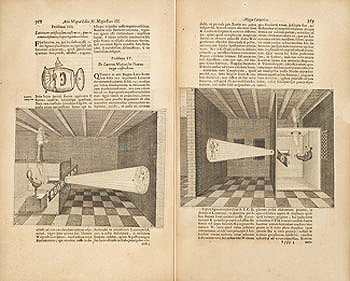

4. Athanasius Kircher.
Ars magna lucis et umbrae. [The Great Art of Light and Shadow.]
2nd revised edition.
Amsterdam: Apud Johannem Janssonium á Waesberge, & haerdes Elizaei
Weyerstraet, 1671.
Descriptions of lanterns that could project shadows survive from the Middle Ages. The first pictures of a lantern projecting an image on the wall, with instructions for its construction and operation, appeared in this treatise on light and optics. There is an English translation of Kircher's Latin text explaining how to make “a sorcerer's lamp” at Mats Rendel's website.
The subjects projected on the wall—a soul suffering in Purgatory and Death with his scythe—were calculated to remind the audience that the wages of sin are death. That the magic lantern could be useful to the Church was clearly not lost on the Jesuit Kircher (1602-1680). He wrote forty-four works on subjects ranging from magnetism to subterranean exploration. He also found time to decipher hieroglyphics, collect antiquities, compose music for automatic instruments, and invent a universal language. The achievements of this seventeenth-century polymath are the subject of an exhibition at the Museum of Jurassic Technology in Los Angeles.
For a fascinating account of the magic lantern as a kind of "magical" technology,
see Devices of Wonder from The World in a Box to Images on a Screen by
Barbara M. Stafford and Frances Terpak (Los Angeles: Getty Research
Institute, 2002).
